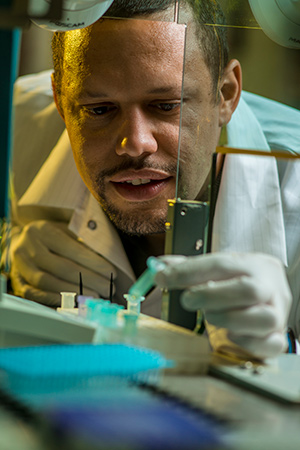From Cells to Circuits
Densmore leads BU team that collaborates with MIT in Science engineering biology study

Whether it’s artificial skin that mimics squid camouflage or an artificial leaf that produces solar energy, a common trend in engineering is to take a page out of biology to inspire design and function. However, an interdisciplinary team of Boston University researchers have flipped this idea, instead using computer engineering to inspire biology in a study published in Science in April 2016.
“When you think about it, cells are kind of computers themselves. They have to communicate with other cells and make decisions based on their environment,” says Douglas Densmore, associate professor of electrical and computer engineering and biomedical engineering, who oversaw the BU research team. “By turning them into circuits, we’ve figured out a way to make cells that respond the way we want them to respond. What we are looking at with this study is how to describe those circuits using a programming language and to transform that programming language into DNA that carries out that function.”
Using a programming language commonly used to design computer chips, electrical and computer engineering graduate student Prashant Vaidyanathan created design software that encodes logical operations and bio-sensors right into the DNA of Escherichia coli bacteria. Sensors can detect environmental conditions while logic gates allow the circuits to make decisions based on this information. These engineered cells can then act as mini processing elements, enabling the large-scale production of bio-materials or helping detect hazardous conditions in the environment. Former postdoctoral researcher Bryan Der facilitated the partnership between BU and the Massachusetts Institute of Technology to pursue this research study.
“Here at BU, we used our strength in computer-aided design for biology to actually design the software and MIT produced the DNA and embedded it into the bacterial DNA,” says Densmore. “Our collaboration is a result of sharing the same vision of standardizing synthetic biology to make it more accessible and efficient.”
Historically, building logic circuits in cells was both time-consuming and unreliable, so fast, correct results are a game changer for research scientists, who get new DNA sequences to test as soon as they hit the “run” button. This novel approach of using a common programming language opens up the technology to anyone, giving them the ability to program a sequence and generate a strand of DNA immediately.
“It used to be that only people with knowledge of computers could build a website, but then resources like WordPress came along that gave people a simple interface to build professional-looking websites. The code was hidden in the back end, but it was still there, powering the site,” says Densmore. “That’s exactly what we are doing here with our software. The genetic code is still there, it is just hidden in the back end and what people see is this simplified tool that is easy, effective, and produces immediate results that can be tested.”
According to Densmore, this study is an important first step that lays the foundation for future research on transforming cells into circuits, and the potential for impact is global, with applications in health care, ecology, agriculture, and beyond. Possible applications include bacteria that can be swallowed to aid in digestion of lactose to bacteria that can live on plant roots and produce insecticide if they sense the plant is under attack.
“The possibilities are endless, and I am excited about it because this is the crucial first step to reach that point where we can do those amazing things,” says Densmore. “We aren’t at that level yet, but this is a stake in the ground that shows us we can do this.”
The BU/MIT collaboration will continue underneath the Living Computing Project, which was awarded a $10 million grant from the National Science Foundation in January 2016. Future studies will look to improve upon the circuits that were tested, add other computer elements like memory to the circuits, and expand into other organisms such as yeast, which will pave the way for implanting the technology into more complex organisms like plant and animal cells.
Comments & Discussion
Boston University moderates comments to facilitate an informed, substantive, civil conversation. Abusive, profane, self-promotional, misleading, incoherent or off-topic comments will be rejected. Moderators are staffed during regular business hours (EST) and can only accept comments written in English. Statistics or facts must include a citation or a link to the citation.